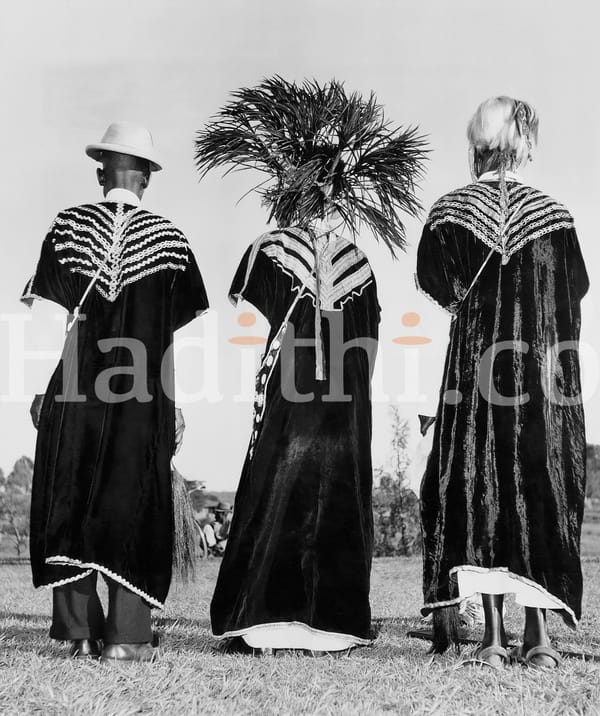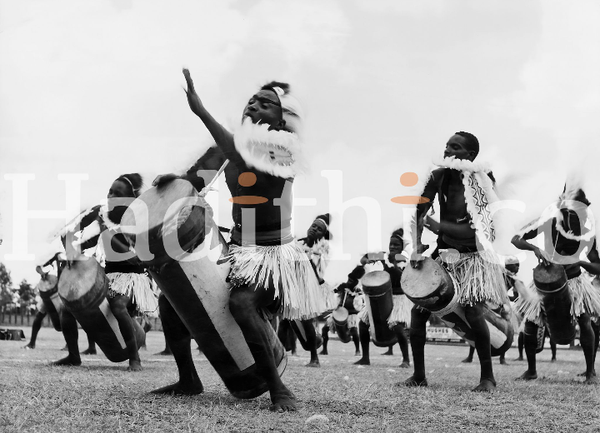The Baganda of Uganda
The Baganda are a Bantu ethnic group who live in central Uganda, also known as the Ganda or Waganda. They speak Luganda, the dominant local language spoken by over eight million people in Uganda.

The Baganda are a Bantu ethnic group who live in central Uganda, also known as the Ganda or Waganda. They speak Luganda, the dominant local language spoken by over eight million people in Uganda. Historically, the Baganda belonged to the Buganda Kingdom, which has survived although the King of Buganda, also known as the Kabaka, only has cultural, not political, powers in modern-day Uganda. As such, the history of the Baganda cannot be separated from the history of the Buganda Kingdom.
The Waganda are divided into 52 clans, but only 46 are officially recognized. They are the largest ethnic group in Uganda, comprising 17% of the country’s population, with an estimated population of 5.56 million people. The Buganda Kingdom is also the largest and most populous kingdom in Uganda. The Ganda are commonly referred to as “King’s Men” because their king plays a key and central role in their society. Historically, the Baganda lived in a highly centralized kingdom until the kingdoms were abolished completely in 1967. In 1993, Uganda reinstated the kingdoms, and Ronald Muwenda Mutebi II became the 36th king (Kabaka) of Buganda.
Origin and History
The early history of the Baganda is unclear because there are multiple conflicting stories of their origin. One tradition holds that they descend from a legendary ancestor known as Kintu, who was the first man in Waganda mythology. Kintu was said to have had a wife known as Nambi, the daughter of Ggulu, the creator deity. A related origin story suggests that Kintu migrated from the east in the Mount Elgon direction and moved through Busoga on his way to Buganda, where he settled. Another story holds that the Baganda descend from people who migrated from the northeast or east in the 14th century. According to Apolo Kagwa, a renowned ethnographer, the Baganda believe that Kintu was the first man (Muganda) and is said to have descended to earth at Podi and moved to Kibiro and Kyadondo, where he formed the kingdom of Buganda.
As a Bantu people, it is most likely that the Waganda migrated from the region between Central and West Africa, in what is now known as Cameroon. They moved to their current location during the Bantu migration and formed the Buganda Kingdom. It is well known that the founder of the Ganda (Buganda) Kingdom was Kato Kintu, who is distinct from the mythical Kintu, and he became the first Kabaka. It is believed that he adopted the name Kintu in reference to the legendary Kintu to gain legitimacy to rule over his people. He successfully united various warring tribes to create a formidable kingdom.
By the 18th century, the Buganda Kingdom had eclipsed and absorbed part of the previously dominant Bunyoro-Kitara Kingdom. The consolidation of power behind a centralized kingdom allowed the Baganda to shift from defensive actions to expanding their empire. By the mid-19th century, the Kingdom of Buganda had significantly expanded by conquering most of Bunyoro, becoming the dominant state/kingdom in the region. It was administered by chiefs elected by the people and answerable to the Kabaka.
The Colonial Era
The first European to arrive in Buganda was the explorer John Speke during his search for the origin of the Nile in the 1860s. After returning to Britain, he gave a glowing account of the Buganda Kingdom as an advanced state in East Africa. The first Christian missionaries arrived in Buganda in 1876 to introduce Christianity to the people. Between 1881 and 1890, the Waganda began to convert to Christianity and Islam. Today, Islam and Christianity are the most popular religions among the Baganda.
According to the journalist Henry Morton Stanley, who visited the kingdom in 1875, the capital of the Buganda Kingdom was a well-organized town of approximately 80,000 people surrounding the king’s compound, located on a commanding hill. He stated that the palace compound was surrounded by a wall over 4 kilometers in circumference. The kingdom was administered from the palace, which consisted of grass-roofed houses, storage buildings, and meeting halls. Communication across the kingdom was done by messengers supplemented by drum signals. The British were highly impressed by the economic, social, and governmental organization of the Buganda Kingdom, ranking it highly along with similarly advanced nations in Nigeria and Zimbabwe.
In 1894, Buganda became a British protectorate under Kabaka Mwanga II. However, the king became dissatisfied with his relationship with the British colonialists and declared war on them on July 6, 1897. His army was defeated by the colonial forces at the Battle of Buddu two weeks later on July 20, 1897. As a result, the Kabaka had to flee to German East Africa (modern-day Tanzania), where he was arrested and imprisoned in Bukoba. He eventually escaped and led a rebel army to retake the kingdom but suffered another defeat in 1898 before being exiled to the Seychelles. He lived the rest of his life in exile and died at the age of 35 in 1903.
The expensive war against Kabaka Mwanga II meant that the commissioner of Uganda, Sir Harry H. Johnston, had to levy taxes by establishing an efficient administration. He approached the Bugandan chiefs and promised them top jobs in the colonial administration if they collaborated. The chiefs accepted the offer, expecting their interests, including private land tenure, the preservation of the kingdom as an autonomous entity, and the continuation of the Kabaka’s royal line, would be protected. After difficult negotiations, the chiefs secured most of what they wanted, including half of the entire land in Buganda. The 1900 agreement also imposed a gun and hut tax, with the chiefs designated as tax collectors and guarantors of the continued alliance between the Baganda and British interests. The Baganda were fortunate because the British signed much less generous treaties with the other kingdoms (Bunyoro in 1933, Ankole in 1901, and Toro in 1900). For instance, those kingdoms did not receive a guarantee of large-scale private land tenure.
After Uganda's independence in 1962, the kingdoms were abolished by Milton Obote, Uganda’s first Prime Minister, in 1966. The kingdoms were reinstated in 1993 after the victory of the National Resistance Movement under Yoweri Kaguta Museveni in 1986. Today, Buganda is a kingdom with some autonomy in Uganda, although tensions between the republic and the monarchy remain. The king continues to have strong influence on the ritual and cultural values of the Waganda and plays an important role in promoting ethnic harmony and unity in the country.
Religion
In the past, the Baganda believed in spiritual gods regarded as the creators of the heavens and earth. These gods were known as the Jaja Muwanga. The Ganda also wore charms believed to protect them from evil forces. They believed that the Jaja Muwanga had agents who did their work on earth, and the community had deep respect for their gods. They built shrines where people would worship the gods.
After Buganda was colonized by the British, Islam and Christianity were introduced to the population. Most of the people in the kingdom converted and became Muslims or Christians. The new religious beliefs in the kingdom became so strong that there is a story of Waganda men who were killed in Namugongo after refusing to denounce Christianity. Ugandans celebrate these men every June 3rd to remember their heroism and religious values.
Culture and Social Organization
The Baganda are divided into clans comprising groups of related lineages. Their society is patriarchal, meaning men take leading positions in decision-making and political affairs. Each lineage within a clan has a leader who is answerable to the clan leaders, while the clan leaders are answerable to the Kabaka. The main role of the clan leaders is to chair the council of lineage heads and solve conflicts among them. They also make decisions regulating marriages between various lineages, often leading to the creation of crucial political and social alliances. The clan leaders and lineage heads also ensure efficient land use.
Family and Marriage
The Waganda have a special term, ‘jangu onfumbire’ (meaning "come cook for me"), to refer to traditional marriage. The father is considered the most important and powerful person in the family. The children and wives kneel before him as a symbol of respect, and he is the first to be served food as the leader of the house. The children have special relationships with their mothers and fear their fathers as a sign of respect.
After marriage, a couple moves into a new homestead built in the man’s village where they live and build a family. Although polygamy is not illegal, most marriages in the kingdom are monogamous.
The Baganda traditional marriage ceremony (kwanjula) is a colorful event representing the transition from childhood to adulthood. It begins with the Kukyala, where the girl introduces her groom to a paternal aunt. In the past, this was a small ceremony, but today, people often hold larger ceremonies by hiring event planners and inviting many friends, depending on their financial power. During the Kukyala, the man is accompanied by a spokesperson and his family. The bride’s family also has a spokesperson who discusses the dowry to be delivered before the marriage can proceed.
After the dowry is agreed upon, the date for the Kwanjula is set. The girl’s family organizes the ceremony, which takes place in their home in the presence of friends and family. During the preparation for the ceremony, the aunts advise the girl on how to behave during the marriage. She is also smeared with herbs to beautify her on the day of the marriage.
On the day of the marriage, the girl wears a Gomesi, the traditional wear for Baganda women, while the groom wears a kanzu and a coat. The man presents the dowry as agreed upon during the Kukyala. As a sign of respect for the kingdom, the man is also required to present a portrait of the Nabageraka (Queen) and the Kabaka. After the Kwanjula is completed, the girl is given permission to move to the groom’s house permanently, as the ceremony is regarded as a legal marriage.
Economic Activities
Like most Bantu communities in Africa, the Baganda society mainly relied on agriculture as a source of livelihood. However, unlike other Bantu kingdoms, cattle only played a small role in Buganda. The staple food among the Waganda was and continues to be, bananas, used for both commercial and subsistence purposes. Women mainly provided labor on the farms, while men engaged in politics and trade. In modern Uganda, the Baganda have diversified into other economic fields such as engineering, medicine, teaching, and information technology, while others work as civil servants in the national and local governments.
References
Kasfir, N. (2019). The restoration of the Buganda Kingdom Government 1986–2014: culture, contingencies, constraints. The Journal of Modern African Studies, 57(4), 519-540.
Kiwanuka, M. S. M. (1972). A History of Buganda from the Foundation of the Kingdom to 1900. Africana Pub. Corp..
Kizza, I. N. (2010). The Oral Tradition of the Baganda of Uganda: a study and anthology of legends, myths, epigrams and folktales. McFarland.
Kodesh, N. (2007). History from the healer's shrine: genre, historical imagination, and early Ganda history. Comparative Studies in Society and History, 49(3), 527-552.
Mulambuzi, F. X. (1997). Beliefs in ancestral spirits: interpreting contemporary attitudes of the Baganda to the ancestors (Doctoral dissertation).
Namayanja, S. (2013). Mythical Implications in the Origin Stories of the Baganda and Bagishu. Matatu: Journal for African Culture & Society, 42(1).
Oliver, R. (1955). The traditional histories of Buganda, Bunyoro, and Nkole. The Journal of the Royal Anthropological Institute of Great Britain and Ireland, 85(1/2), 111-117.




